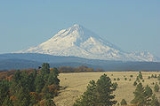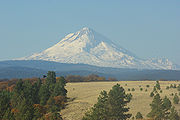
Pine Hollow, Oregon
Encyclopedia
Pine Hollow is a census-designated place
(CDP) and unincorporated community in Wasco County
, Oregon
, United States
. The population was 424 at the 2000 census.

Pine Hollow is located at 45°14′42"N 121°17′54"W (45.245043, -121.298376). The community is located 1886 feet (574.9 m) above sea-level.
According to the United States Census Bureau
, the CDP has a total area of 2.6 square miles (6.7 km²), of which, 2.3 square miles (6 km²) of it is land and 0.3 square mile (0.776996433 km²) of it (11.97%) is water.
The Pine Hollow region is a series of steep narrow gulches with their heads generally extending toward Mount Hood and flowing northeast, with flatter ridges in between. The forest cover gradually increases as to the west. To the east, the portion of the lands that can be farmed (mostly dryland wheat) increases. The fields that are farmed are often very steep and Caterpillar tractors used for "farm cats" are common.
of 2000, there were 424 people, 197 households, and 152 families residing in the CDP. The population density
was 186.0 people per square mile (71.8/km²). There were 435 housing units at an average density of 190.8/sq mi (73.7/km²). The racial makeup of the CDP was 94.10% White, 0.94% Native American, 1.18% Pacific Islander, 1.42% from other races
, and 2.36% from two or more races. Hispanic or Latino of any race were 2.83% of the population.
There were 197 households out of which 10.7% had children under the age of 18 living with them, 72.6% were married couples
living together, 3.0% had a female householder with no husband present, and 22.8% were non-families. 19.3% of all households were made up of individuals and 8.6% had someone living alone who was 65 years of age or older. The average household size was 2.15 and the average family size was 2.41.
In the CDP the population was spread out with 13.2% under the age of 18, 3.1% from 18 to 24, 9.7% from 25 to 44, 45.5% from 45 to 64, and 28.5% who were 65 years of age or older. The median age was 58 years. For every 100 females there were 99.1 males. For every 100 females age 18 and over, there were 95.7 males.
The median income for a household in the CDP was $37,667, and the median income for a family was $37,604. Males had a median income of $37,083 versus $16,250 for females. The per capita income
for the CDP was $16,537. About 9.1% of families and 10.5% of the population were below the poverty line, including 14.9% of those under age 18 and 7.0% of those age 65 or over.
Census-designated place
A census-designated place is a concentration of population identified by the United States Census Bureau for statistical purposes. CDPs are delineated for each decennial census as the statistical counterparts of incorporated places such as cities, towns and villages...
(CDP) and unincorporated community in Wasco County
Wasco County, Oregon
Wasco County is a county located in the U.S. state of Oregon. The county is named for a local tribe of Native Americans, the Wasco, a Chinook tribe who lived on the south side of the Columbia River. In 2010, its population was 25,213...
, Oregon
Oregon
Oregon is a state in the Pacific Northwest region of the United States. It is located on the Pacific coast, with Washington to the north, California to the south, Nevada on the southeast and Idaho to the east. The Columbia and Snake rivers delineate much of Oregon's northern and eastern...
, United States
United States
The United States of America is a federal constitutional republic comprising fifty states and a federal district...
. The population was 424 at the 2000 census.
Geography

Pine Hollow is located at 45°14′42"N 121°17′54"W (45.245043, -121.298376). The community is located 1886 feet (574.9 m) above sea-level.
According to the United States Census Bureau
United States Census Bureau
The United States Census Bureau is the government agency that is responsible for the United States Census. It also gathers other national demographic and economic data...
, the CDP has a total area of 2.6 square miles (6.7 km²), of which, 2.3 square miles (6 km²) of it is land and 0.3 square mile (0.776996433 km²) of it (11.97%) is water.
The Pine Hollow region is a series of steep narrow gulches with their heads generally extending toward Mount Hood and flowing northeast, with flatter ridges in between. The forest cover gradually increases as to the west. To the east, the portion of the lands that can be farmed (mostly dryland wheat) increases. The fields that are farmed are often very steep and Caterpillar tractors used for "farm cats" are common.
Demographics
As of the censusCensus
A census is the procedure of systematically acquiring and recording information about the members of a given population. It is a regularly occurring and official count of a particular population. The term is used mostly in connection with national population and housing censuses; other common...
of 2000, there were 424 people, 197 households, and 152 families residing in the CDP. The population density
Population density
Population density is a measurement of population per unit area or unit volume. It is frequently applied to living organisms, and particularly to humans...
was 186.0 people per square mile (71.8/km²). There were 435 housing units at an average density of 190.8/sq mi (73.7/km²). The racial makeup of the CDP was 94.10% White, 0.94% Native American, 1.18% Pacific Islander, 1.42% from other races
Race (United States Census)
Race and ethnicity in the United States Census, as defined by the Federal Office of Management and Budget and the United States Census Bureau, are self-identification data items in which residents choose the race or races with which they most closely identify, and indicate whether or not they are...
, and 2.36% from two or more races. Hispanic or Latino of any race were 2.83% of the population.
There were 197 households out of which 10.7% had children under the age of 18 living with them, 72.6% were married couples
Marriage
Marriage is a social union or legal contract between people that creates kinship. It is an institution in which interpersonal relationships, usually intimate and sexual, are acknowledged in a variety of ways, depending on the culture or subculture in which it is found...
living together, 3.0% had a female householder with no husband present, and 22.8% were non-families. 19.3% of all households were made up of individuals and 8.6% had someone living alone who was 65 years of age or older. The average household size was 2.15 and the average family size was 2.41.
In the CDP the population was spread out with 13.2% under the age of 18, 3.1% from 18 to 24, 9.7% from 25 to 44, 45.5% from 45 to 64, and 28.5% who were 65 years of age or older. The median age was 58 years. For every 100 females there were 99.1 males. For every 100 females age 18 and over, there were 95.7 males.
The median income for a household in the CDP was $37,667, and the median income for a family was $37,604. Males had a median income of $37,083 versus $16,250 for females. The per capita income
Per capita income
Per capita income or income per person is a measure of mean income within an economic aggregate, such as a country or city. It is calculated by taking a measure of all sources of income in the aggregate and dividing it by the total population...
for the CDP was $16,537. About 9.1% of families and 10.5% of the population were below the poverty line, including 14.9% of those under age 18 and 7.0% of those age 65 or over.

